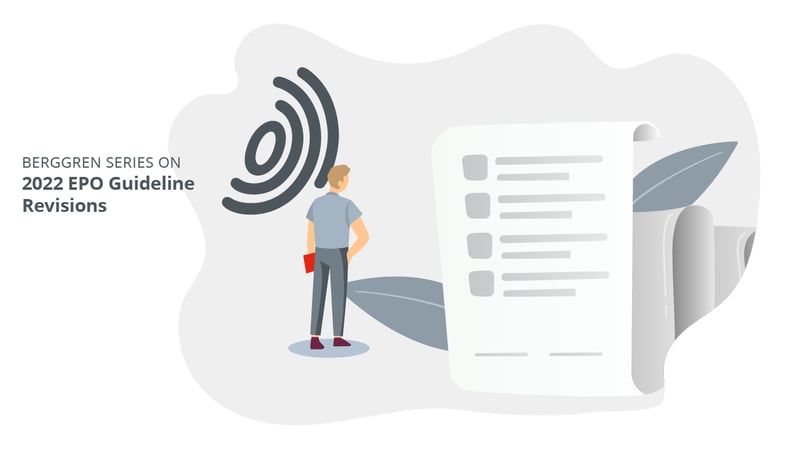This is the second article in our 2022 weekly series addressing updates to the European Patent Office’s Guidelines for Examination. This week we review changes to partial priority law in Europe. For the next several weeks, Berggren will address other revisions to the Guidelines in the European patent section of the Lexology newsfeed.
The right to priority has been enshrined in Article 4 of the Paris Convention since 1883. Even so, the interpretation of this provision and its corresponding provision in the European Patent Convention (Art. 87 EPC) remains an important topic, as evidenced by the updates to section F-VI, 1.5 of the 2022 Guidelines. These updates reflect two decisions of the EPO’s Boards of Appeal (T 282/12 and T 969/14) following the decision of the Enlarged Board of Appeal in G 1/15 on partial priorities of “generic OR claims”.
In particular, according to T 282/12, the rationale of G 1/15 also applies when assessing the “first application” in the context of Art. 87(1) EPC. Moreover, the 2022 version of the Guidelines also warns of possible consequences of a partial transfer of the priority right in view of the decision in T 969/14.
Priority right overview
As a general rule, the scope of the relevant prior art that can be applied to a patent application (or issued patent) is determined by its filing date. The priority right provides a period of 12 months during which the earlier filing date of an application, A1, can be “transferred” to a later application, A2, thereby limiting the scope of the prior art that can be applied to A2. By virtue of a validly claimed priority right, A2 enjoys the filing date of A1.
One of the criteria for a validly claimed priority right is that the later application A2 deals with the same invention as the earlier application A1, i.e. A1 and A2 must relate to the same subject matter. If the invention of the later application A2 relates an invention other than A1, A2 does not enjoy the right to the priority of A1 so that the earlier filing date of A1 cannot be applied to A2. For example, if A1 relates to a mobile phone and A2 relates to a bicycle, A2 cannot validly claim the priority of A1.
In practice, it is quite rare that A2 relates to something completely different than A1. It is more common that the invention of the later application A2 is more general in scope than the invention of A1. For instance, the earlier application A1 may relate to a bicycle that is made of aluminum and the later application A2 to a bicycle that is made of aluminum or iron. According to established case law of the EPO’s Boards of Appeal, the filing date of A1 can be accorded to A2 only insofar as A2 relates to a bicycle made of aluminum. Where the later application A2 relates to a bicycle made of iron, it is not entitled to the same filing date as A1 but has its own later filing date.
G 1/15: partial priority of a generic OR claim
Consider again the case where A1 relates to a bicycle made of aluminum. However, A2 relates to a bicycle made of metal. Clearly, aluminum is a metal, but it is also evident that A2 encompasses a bicycle which is made of other metals, such as iron, and as indicated in the above example A2 cannot enjoy the priority of A1. One difference is that in the above example the alternatives are spelled out (“aluminum or iron”), whereas in the present case it must be assessed whether the right to priority can still be claimed where the later application A2 relates to a more general invention (“metal”) than the earlier application A1 (“aluminum”). This is the issue that was addressed in G 1/15.
Expressed in the language of the EPO’s Boards of Appeals, a patent claim having the wording “bicycle made of metal” can be referred to as a “generic OR claim”, the “OR” meaning that the claimed subject matter can be split up into a “bicycle made of metal, wherein the metal is aluminum OR a metal different from aluminum.” The “generic” aspect of the claim is that it does not spell out the term “OR” (i.e. the claim does not read “aluminum OR a metal different from aluminum”) but generically defines “metal.”
The conclusion reached in G 1/15 is that A2 (“bicycle made of metal”) validly claims the priority of A1 (“bicycle made of aluminum”) insofar as A2 relates to a bicycle made of aluminum. In contrast, where the later application A2 relates to a bicycle made of a metal different from aluminum, the priority claim is not valid.
While this may seem to be an obvious result, it should be kept in mind that the EPO follows a strict approach when it comes to generalizations and the broadening of claimed subject matter during prosecution. That is, since an (otherwise unsupported) amendment of a claimed feature “aluminum” to “metal” would in general have no chance before the EPO, it was by not clear how the EPO would address the situation where the priority claim of a generic feature like “metal” is only supported by a more specific feature like “aluminum” in the priority application.
T 282/12: partial priority in the context of the first application (Art. 87(1) EPC)
A further requirement for a validly claimed priority is that the application A1 from which the priority right is drawn must be the first application disclosing the invention (cf. Art. 87(1) EPC). In general, in case of an even earlier application, A0, dealing with the same invention as A1, A2 cannot validly claim the priority of A1.
The relation between A1 and A2 as discussed above in the context of G 1/15 may also occur between A0 and A1. Let us assume that A0 relates to the “bicycle made of aluminum” and both A1 as well as A2 relate to the “bicycle made of metal”. According to T 282/12, the principles of G 1/15 are applicable when assessing whether A0 or A1 counts as the first application. That is, A1 is not the first application disclosing a “bicycle made of a metal, wherein the metal is aluminum” because A0 relates to a “bicycle made of aluminum”, but A1 is the first application relating to a “bicycle made of a metal different from aluminum”. Thus, A1 only establishes a priority right with respect to a “bicycle made of a metal different from aluminum” and A2’s priority claim drawn from A1 is not valid with respect to a “bicycle made of aluminum”.
Such a situation may be avoided by timely conducting appropriate measures with respect to the earliest application A0, such as withdrawing A0 and the right to claim priority from it, so that it does not count as the first application based on Art. 87(4) EPC. One should be aware that such measures would have to be taken at an early stage, in particular prior to A0’s publication.
T 969/14: Partial transfer of priority
In T 969/14, the right to claim priority from an application A1, insofar as a specific embodiment is concerned, was transferred from an assignor to an assignee. Based on G 1/15, the Board concluded that a partial priority right had been validly transferred (e.g., a bike made of aluminum), while the residual partial priority right (the bike made of metal different from aluminum) remained with the assignor. For this reason, the competent Board ruled that the broad priority claim (“bike made of metal”) of the assignor’s patent was partially invalid (insofar as the “bike made of aluminum” was concerned) because the assignor no longer held the priority right for the specific embodiment.
Under such circumstances, one might solve this problem by limiting the claimed scope to match the scope of the partial priority right. However, limiting the scope claimed in such a way may not be possible in view of the EPO’s strict approach regarding added subject matter. Therefore, transfer of a partial priority right, may create a situation where the value of the potential patent is greatly reduced.
The decision in T 969/14 is now incorporated into the 2022 EPO Guidelines.
Comments and conclusion
While the EPO’s now-established practice towards partial priority is rather lenient, the examples illustrated above highlight the importance of paying close attention to issues concerning priority claims, both in terms of the substantive requirements as well as formal requirements, as we earlier discussed here.
In particular, applicants should continue to bear in mind that, despite the discussion of priority in the Guidelines for Examination, EPO examining divisions rarely investigate the validity of a priority claim thoroughly before grant. If priority is a contentious issue, it is typically raised in post-grant proceedings, at which time the stakes are higher and the patentee’s hands are somewhat tied by stricter rules on the kinds of amendments that can be made to a patent compared to an application.
(For your ease of reference, last week´s Lexology article on updates to the Guidelines related to amendments to the description can be found here.)
This is the second article in our 2022 weekly series addressing updates to the European Patent Office’s Guidelines for Examination. Read the first article of this series here.

